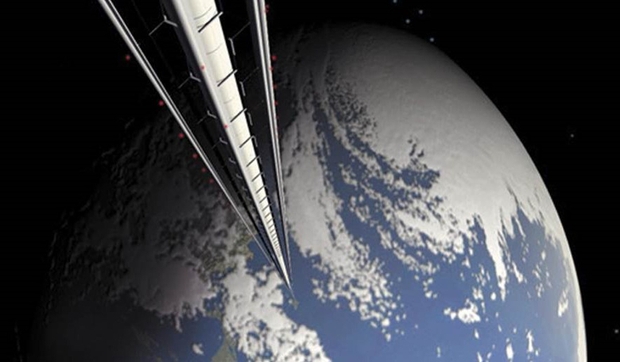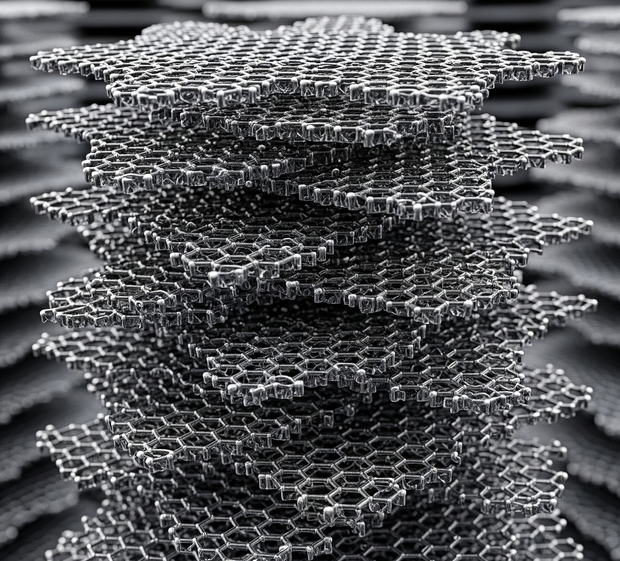https://api.follow.it/track-rss-story-click/v3/jGd80SoQARXQxOl5xf_jQZqTjJgfb5qG

The advantages of a space elevator have been percolating through the aerospace community for quite some time, particularly boosted by Arthur C. Clarke’s novel The Fountains of Paradise (1979). The challenge is to create the kind of material that could make such a structure possible. Today, long-time Centauri Dreams reader Adam Kiil tackles the question with his analysis of a new concept in producing graphene, one which could allow us to create the extraordinarily strong cables needed. Adam is a satellite image analyst located in Perth, Australia. While he has nursed a long-time interest in advanced materials and their applications, he also describes himself as a passionate advocate for space exploration and an amateur astronomer. Today he invites readers to imagine a new era of space travel enabled by technologies that literally reach from Earth to the sky.
by Adam Kiil

In the quiet predawn hours, a spider spins its web, threading together a marvel of biological engineering: strands that are lightweight, elastic, and capable of absorbing tremendous energy before failing. This isn’t just nature’s artistry; it’s a lesson in hierarchical design, where proteins self-assemble into beta-pleated sheets and amorphous regions, creating a material tougher than Kevlar — able to dissipate impacts like a shock absorber — while outperforming steel in strength-to-weight ratio, though falling short of Kevlar’s raw tensile strength.
As we gaze upward toward the stars, dreaming of bridges to orbit, such bio-inspired ingenuity beckons. Could we mimic this to construct a space elevator tether, a ribbon stretching 100,000 kilometers from Earth’s equator to geostationary orbit and beyond? The demands are staggering: a material with a specific strength exceeding 50 GPa·cm³/g to support its own weight against gravity’s pull, all while withstanding radiation, micrometeorites, and immense tensile stresses. [GPa is a reference to gigapascals, the units used to measure tensile strength at high pressures and stresses. Thus GPa·cm³/g represents the ratio of strength to density].

Image: A space elevator is a revolutionary transportation system designed to connect Earth’s surface to geostationary orbit and beyond, utilizing a strong, lightweight cable – potentially made of graphene due to its extraordinary tensile strength and low density—anchored to an equatorial base station and extending tens of thousands of kilometers to a counterweight in space. This megastructure would enable low-cost, efficient transport of payloads and people into orbit, leveraging a climber mechanism that ascends the cable, potentially transforming space access by reducing reliance on traditional rocket launches. Credit: Pat Rawlings/NASA.
Enter a recent breakthrough in graphene production from professor Chris Sorensen at Kansas State University and Vancouver-based HydroGraph Clean Power, whose detonation synthesis yields pristine, fractal, and reactive graphene — potentially a key ingredient in weaving this cosmic thread.
But this alone may not suffice; we must think from first principles, exploring uncharted solutions to assemble nanoscale wonders into macroscale might.
Graphene’s Promise and Perils: The Historical Context
Graphene, that atomic-thin honeycomb of carbon, tantalizes with its theoretical tensile strength of 130 GPa and density of 2.2 g/cm³, yielding a specific strength around 59 GPa·cm³/g—right on the cusp of space elevator viability.
Yet, production has long been the bottleneck. Chemical vapor deposition churns out high-quality but limited sheets; mechanical exfoliation delivers impure, aggregated flakes. These yield composites where graphene platelets, bound weakly by van der Waals forces (mere 0.1-1 GPa), slip under strain, like loose pages in a book. For a tether, we need seamless load transfer, hierarchical reinforcement, and defect minimization—echoing the energy-dissipating nanocrystals in spider silk’s protein matrix.
Sorensen’s Detonation Concept: Fractal and Reactive Graphene
Chris Sorensen’s innovation at HydroGraph Clean Power flips the script. Using a controlled detonation of acetylene and oxygen in a sealed chamber, his team produces graphene with over 99.8% purity, fractal morphology, and tunable reactivity—all at scale, with zero waste and low emissions.
The fractal form — branched, snowflake-like platelets with 200 m²/g surface area — enhances interlocking, outperforming traditional graphene by 10-100 times in composites, but crucially, these gains shine at ultra-low loadings (0.001%) and under modest stresses, not yet the gigapascal realms of a space elevator.
Reactive variants add edge functional groups like carboxylic acids (COOH), enabling covalent bonding—yet, note that simple condensation reactions here yield strengths akin to polymer chains (1-5 GPa), not the in-plane prowess of graphene’s sp² lattice.This fractal graphene could form a foundational scaffold, reconfigurable into aligned structures that mimic bone’s porosity or silk’s hierarchy. Earthly spin-offs abound: tougher concrete, sensitive sensors, efficient batteries. But for the stars, we must bridge the gap from nanoplatelets to kilometer-long cables.

Image: Conceptual view of Hydrographs’ turbostratic, 50nm nanoplatelets, 99.8% pure carbon, sp2 bonded graphene. Credit: Adam Kiil.
From First Principles: Many Paths to a Cosmic Thread
To transcend these limits, let’s reason from fundamentals. A space elevator tether must maximize tensile strength while minimizing density and defects, distributing stress across scales like spider silk’s beta-sheets (crystalline strength) embedded in an extensible amorphous matrix.
Graphene’s strength derives from its delocalized electrons in a defect-free lattice; any assembly must preserve this while forging inter-platelet bonds rivaling intra-platelet ones. Current methods fall short, so here are myriad speculative solutions, drawn from physics, chemistry, and biology—some extant, others nascent or hypothetical, demanding innovation:
- Edge-Fusion via Plasma or Laser Annealing: Functionalize edges with hydrogen or halogens, then use plasma arcs or femtosecond lasers to fuse platelets into seamless, extended sheets or ribbons, healing defects to approach single-crystal continuity. This could yield tensile strengths nearing 100 GPa by eliminating weak interfaces.
- Supramolecular Self-Assembly in Liquid Crystals: Disperse fractal graphene in nematic solvents, applying shear or electric fields to align platelets into helical fibrils, stabilized by pi-pi stacking and hydrogen bonding. Inspired by silk’s pH-induced assembly, this bottom-up approach might create defect-tolerant bundles with built-in energy dissipation.
- Bio-Templating with Engineered Proteins: Design peptides (via AI like AlphaFold) that bind graphene edges, mimicking silk spidroins’ repetitive motifs to fold platelets into hierarchical nanocrystals. Extrude through microfluidic spinnerets, acidifying to trigger beta-sheet formation, embedding graphene in a tough, elastic matrix.
- Covalent Cross-Linking with Boron or Nitrogen Dopants: Introduce boron atoms during detonation to create sp³ bridges between platelets, forming diamond-like nodes in a graphene network. This could boost shear strength to 10-20 GPa without sacrificing tensile properties, verified by molecular dynamics.
- Electrospinning with Magnetic Alignment: Mix reactive graphene in a polymer dope, electrospin under magnetic fields to orient platelets, then pyrolyze the polymer, leaving aligned, sintered graphene fibers. Enhancements: Add ultrasonic waves for dynamic packing, targeting <1 defect per 100 nm².
- Hierarchical Bundling via 3D Printing: Nanoscale print graphene inks layer-by-layer, using click chemistry (e.g., thiol-ene) for instant cross-links. Scale up to micro-bundles, then macro-cables, tapering density like a tree trunk to root.
- Dynamic Compression and Sintering: Apply gigapascal pressures in a diamond anvil cell, combined with heat, to induce partial sp²-to-sp³ transitions at overlaps, creating hybrid structures akin to lonsdaleite—ultra-hard yet flexible.
- Biomineralization Analogs: Introduce calcium or silica ions to reactive groups, mineralizing interfaces like nacre, adding compressive strength and crack deflection.
- AI-Optimized Hybrid Composites: Simulate (via quantum computing) blends of fractal graphene with silk-mimetic polymers or boron nitride, optimizing ratios for 90% tensile efficiency. Fabricate via wet-spinning, testing at centimeter scales.
These aren’t exhaustive; hybrids abound—e.g., combining bio-templating with laser fusion. Each target’s aim: moving beyond low-load enhancements and polymer-like bonds to harness graphene’s full lattice strength.
Weaving and Laminating: Practical Steps Forward
Drawing from these, a viable process might start with a high-solids dispersion of reactive fractal graphene, extruded via wet-spinning into aligned fibers, where optimized cross-linkers (not mere condensations) ensure graphene-dominant strength. Stack into nacre-like laminates, using hot isostatic pressing (5-20 GPa) to forge sp³ bonds, elevating shear (and thus overall tensile) resilience to 10-20 GPa. Taper the structure: thick at the base for 7 GPa stresses, thinning upward.
Scaling leverages HydroGraph’s modular reactors, producing tonnage graphene for kilometer segments.
Join via overlap lamination, braid for redundancy, deploy from orbit. Prototypes must demonstrate cohesive failure, >90% load transfer, via nanoindentation.
A Bridge to the Cosmos
Sorensen’s detonation-born graphene, fractal and reactive, ignites possibility. Yet, as spider silk teaches, true mastery lies in hierarchy and adaptation.
Success means a tether with inter-platelet bond strength nearing single-crystal graphene (>100 GPa), verified by nanoindentation or pull-out tests, with >90% tensile transfer efficiency. Centimetre-scale prototypes should show minimal defects (<1 per 100 nm² via TEM), failing cohesively, not delaminating, like a spider’s web holding under a gale. The full tether, massing under 500 tonnes, could be deployed from orbit, a lifeline to the cosmos. This graphene tether embodies our ‘sea-longing,’ a bridge to the stars woven from carbon’s hexagons, inspired by nature’s spinners and builders.
By innovating from first principles—fusing, assembling, templating—we edge closer to stitching the stars. This isn’t mere materials science; it’s the warp and weft of humanity’s interstellar tapestry, a web to catch the dreams of Centauri and beyond.

https://api.follow.it/track-rss-story-click/v3/jGd80SoQARXQxOl5xf_jQZqTjJgfb5qG



![Welcome to the Linguistics Department - It has been [2] [DAYS] since someone noticed that the Biology Department sign has a one-day-long singular/plural disagreement after it resets. Welcome to the Linguistics Department - It has been [2] [DAYS] since someone noticed that the Biology Department sign has a one-day-long singular/plural disagreement after it resets.](https://imgs.xkcd.com/comics/biology_department.png)














